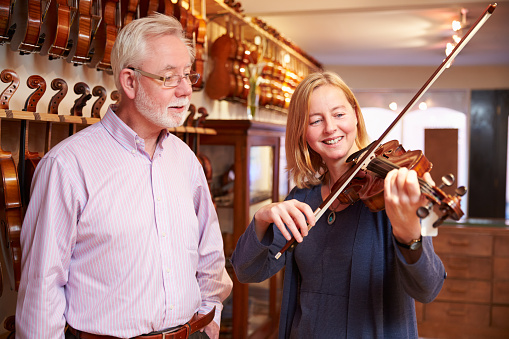To fully unlock your potential as a violinist, you need more than lots of practice and rehearsal time or the right violin — you also require a bow that matches your playing needs as well as the strengths of your violin. So what do you look for in your own personal abilities when buying a new violin bow? Skill level. Playing style. The specific kind of sound you are trying to generate from your instrument. Music genre. These are all factors you should consider when bow shopping.
In his nonfiction book, “Absolutely on Music: Conversations with Seiji Ozawa,” Haruki Murakai writes, “To build something where there was nothing requires deep individual concentration.” To build and generate the perfect violin sound begins with identifying and playing the right bow with deep concentration. And once you have found the right bow, its presence will slowly begin to fade from your mind, becoming an extension of you and your violin.
Follow this guide to get a detailed synopsis of what to look for when buying a violin bow and you will be on your way to giving your best performance.
Bow Types
To start, you should want a bow that compliments your current skill set as a violinist. If you are a beginner, you should not be shopping master bow categories from premium bow makers. Likewise, if you are playing with your old student bow but are now a performer at a high level, you are due for an upgrade. When bow shopping, a helpful thought is to consider whether the bow you are playing aids or hinders your musical abilities. If you feel hindered, then you know to keep looking.
A significant factor that will aid or hinder your performance is the type of bow you play with.
The three main bow types for violinists to consider are:
- Brazilwood
- Carbon fiber
- Pernambuco
For generations, brazilwood was a popular choice for violin bows. Strong and resilient, many developing musicians used this type of bow as their go-to, given its affordability. However, brazilwood of a good quality for bow making has become increasingly difficult to find. This is because sourcing has become problematic, as certain types of brazilwood, which is a general name for many types of wood from Brazil, are at risk of extinction due to overharvesting.
Pernambuco is a specific type of brazilwood, coming from the heartwood of the tree. Meanwhile, the rest of the wood from the tree is what’s used to craft brazilwood bows. Though brazilwood and pernambuco come from the same trees, they have different color and density. Brazilwood tends to be more brown, whereas pernambuco is often orange-brown or even red-brown in color. Pernambuco is also much denser than its brazilwood cousins, making it a stronger bow that provides greater control and vibrancy.
Carbon fiber bows have been around for roughly half a century but it’s in the last 20 years or so they’ve become a mainstream favorite for violinists. They are increasing in popularity due to their durability, affordability, and they are able to replicate many of the best qualities found in pernambuco bows.
Five times stronger than steel, but very lightweight, carbon fiber can withstand everyday life and a range of travel conditions. Carbon fiber bows are meant to last, and playing with one will make it easier to travel with your violin, as you won’t have to worry about going through international customs with a carbon fiber bow. The carbon fiber in the bow also won’t expand or contract due to temperature, as happens with wood bows.
Sound Considerations
If you’ve ever wondered how a bow can affect the sound coming from your violin, take a bow, play some sheet music for a couple minutes and then switch to an entirely different bow, and then play the same section of sheet music. If you’ve never done this before, you’ll be amazed at how different it sounds.
Stiffness, and whether you prefer firm or supple action directly impact the sound you will generate. Most classical musicians prefer supple action, which is capable of nuanced, layered expressions, whereas firm action tends to be more appealing for violinists seeking rapid connection — like fiddlers. And when playing the right bow with good technique, you will get a clear, precise sound, regardless of genre.
The Weight of a Violin Bow
Weight, which is the static mass of a bow, is often overlooked but it shouldn’t be. Violin bows are usually 58 to 62 grams, and their weight affects the comfort and efficiency of a player’s performance while using that bow. That preference can impact playing style and will directly impact performance. For example, lighter bows tend to be more delicate and easier to maneuver, whereas a heavier bow may feel sturdy and improve confidence. The weight you play with should be based on your preferences, and as you gain skill and confidence, you will develop a feel for what weight you desire.
Balance is also key, as it determines how the weight of a bow is distributed. If a player likes to control and direct the bow, they will want a bow that has a frog-favored balance. A tip-favored balance will feel steady in the hand, producing a focused tone for violinists who prefer stability and contact with their strings.
CodaBow — a Convenient Option with Unrivaled Quality
Now that you know what to look for when buying a violin bow, you are ready to shop. If you’ve decided carbon fiber is the right choice for you, but you aren’t ready to commit to a specific bow, ensure you get the bow that matches your needs with CodaBow’s seven-day, in-home trial. You can also try one of our award-winning, carbon fiber bows in person at your local CodaBow dealer. All CodaBows come with a robust warranty to protect your investment. Feel free to sign up on our email list for additional information to experience the CodaBow difference.



Stay Connected